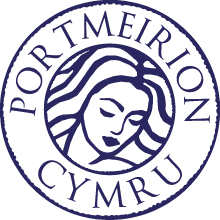
Clough's lifelong concern was with Architecture, Landscape Design, the protection of Rural Wales and Conservation. At Portmeirion, Clough gave his ideas physical and practical expression.
""I think that Beauty, The Strange Necessity - as Rebecca West once called it - is something that matters profoundly to humanity, and that unless the race of man perishes from the earth, it will increasingly value that Grace, will seek it, and will ultimately attain it." - Sir Clough Williams-Ellis"
Bertram Clough Williams-Ellis, Kt. CBE. MC. LLD. FRIBA. FRTPI. FILA etc. (1883-1978). Born at Gayton, Northamptonshire on 28 May the second son of the Rev. John Clough Williams-Ellis and Ellen Mabel Greaves. Educated at Oundle School; Trinity College, Cambridge; the Architectural Association School, London (for three months, 1902-03).
Best known as the genius behind the creation of Portmeirion Village (1925 to 1975), Clough was a tireless campaigner for the environment and a founding member of both CPRE (Council for the Protection of Rural England) established in 1926 and CPRW (now Campaign for the Protection of Rural Wales) in 1928. He was an advocate of rural preservation, amenity planning, industrial design and colourful architecture. "I think that Beauty, The Strange Necessity - as Rebecca West once called it - is something that matters profoundly to humanity, and that unless the race of man perishes from the earth, it will increasingly value that Grace, will seek it, and will ultimately attain it."
He was an influential advocate of the establishment of National Parks in England and Wales and was responsible for the demarcation of Snowdonia National Park's boundary which he presented to King George and Queen Elizabeth in 1951. He built for clients in Wales, England and Ireland and even once in Shanghai. His contribution to architecture has been considerable.
In 1915 he married Amabel Strachey (1894 -1984). They met at a meeting at which he took up a challenge set by her father St. Loe Strachey, editor-proprietor of The Spectator to design affordable rural housing.
Clough and Amabel were married at St. Martha's Church on the Pilgrims' Way on 31st July 1915. Clough was a volunteer Lieutenant in the Welsh Guards and later served in the Royal Tank Corps till 1918 (awarded the Military Cross). They had two daughters, Susan, an Artist (married Euan Cooper-Willis 1945, four children), and Charlotte, a Scientist (married Lindsay Wallace 1945, five children) and one son Christopher (1923-1944), who fell in action before Monte Cassino as an ensign in the Welsh Guards.
Clough's masterpiece, Portmeirion Village, has been an inspiration to fellow architects, most notably to Frank Lloyd Wright who came in 1956 during his one and only visit to his ancestral country - Wales. Clough wanted to demonstrate that architectural good manners were good for business. Portmeirion stands as a testament to his vision and his genius.
"Now Portmeirion, having celebrated its fiftieth birthday in 1976 with suitable gaiety and ebullience, has in a curious and most gratifying way, taken over from me to stand in my place as I myself recede into the friendly shade of the middle nineties." - Sir Clough Williams-Ellis, 1977












